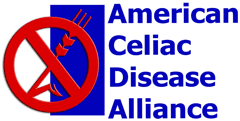Question: I just got diagnosed with celiac disease and my two children also have food allergies. Can you give me any tips on eating out safely… and easily?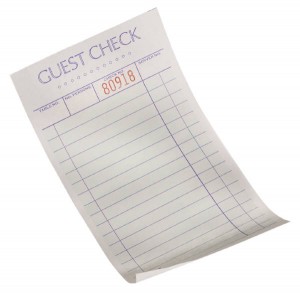
Answer: Eating out can be a real challenge, especially when you are first learning about the gluten-free diet, so I recommend mastering the basics of the diet before venturing out to eat in restaurants. But once you’re ready to eat, there are a growing number of restaurants that are gluten-free (GF) friendly. Many have a GF menu or they’re willing to make adaptations and substitutions in order to meet the needs of the GF customer. Also it’s exciting to see initiatives like the Gluten Free Restaurant Awareness Program (GFRAP) from the Gluten Intolerance Group (GIG) that includes educational and training materials for restaurants and their staff. Once they meet specific criteria they are listed on the GFRAP website so that individuals can search participating restaurants in North America by restaurant name or city and type of cuisine. Check out www.glutenfreerestaurants.org
There are many other great resources to help you eat out and travel safely:
1. The Celiac Scene™ features a free database and downloadable maps of restaurants that locals with celiac disease trust in cities across the USA and Canada. Owned and updated by an individual with celiac disease. Many restaurants bear the special symbol of the Gluten-Free Restaurant Awareness Program.
2. Glutenfreeonthego.com is another free online global directory of over 6000 GF listings of restaurants, bakeries, hotels, resorts, spas, cruises and more. Recommendations are submitted by individuals with celiac disease or others following a GFD, as well as individual GF eating establishments.
3. Glutenfreepassport.com has a variety of resources on safe GF travel and dining. One is a great book called Let’s Eat Out with Celiac and Food Allergies that provides practical information on eating out in regular and ethnic restaurants. It includes 7 international cuisines with hundreds of menus items showcasing common ingredients, hidden allergens and food preparation techniques used by chefs and restaurants. In addition they have cuisine specific pocket size guides that include sample menus, menu dish descriptions, preparation techniques, quick reference guides and questions to ask to ensure safe meals. Another handy resource is the multi-lingual phrase pocket guide that has over 1200 translations from English to French, Spanish, German and Italian. The phrases include dining requests, ingredients, specific preparation requests, sample menus and over 300 health phrases in 4 languages. They have also just released new iPhone/iPod touch applications for some of their resources.
Listen to my podcast (scroll down to podcast #3) with Kim Koeller, co-author of “Let’s Eat Out: Your Passport to Living Gluten-Free and Allergy-Free.” It features an informative discussion on Kim’s newly released revised edition on eating out in regular and ethnic restaurants around the world and tips to eat out safely.
4. Triumph Dining has an Essential GF Restaurant Guide that features over 5000 restaurants across the US listed in a state by state directory and every listing is verified and updated each year by an individual with celiac disease. And the Guide has 80 GF lists from various chain restaurants. Triumph Dining also has laminated wallet sized dining cards for 10 different cuisines. One side of the card is in English and the other side in the foreign language.
5. Bob and Ruth’s Gluten-Free Dining and Travel Club is a company specializing in assisting individuals on a GFD. They offer escorted GF getaways to resorts, on cruises and tours of exotic places all over the world. All the arrangements are taken care of and you can eat safely in these various locations with fellow gluten-free travelers while enjoying a wonderful vacation. My husband and I booked a one week trip with Bob and Ruth a few years ago to the Caribbean. We stayed at the Club Med and not only was the food fantastic and safe, but we met so many nice people.
Here are a few tips for a safe and successful dining experience for those with celiac disease, as well as any intolerance or dietary restriction:
1. Call the restaurant the day before or earlier in the day and ask to speak to the chef or manager to discuss meal options. They can often substitute other ingredients or create an alternative menu or menu item.
2. If possible try to avoid peak meal times. Dining early or late will allow more time and easier access to the staff that can answer questions and usually accommodate special needs.
3. Explain your dietary restrictions briefly. The terms celiac disease is still often unfamiliar to many to those in the food service industry. So I often find it easier to explain that you have a serious food allergy and will get very sick if your order is not handled properly. Indicate that you must not have any foods or ingredients containing gluten which means no items made with wheat flour, breading, croutons, etc. It often helps to ask to speak to the manager or chef to make sure the order gets placed properly and prepared safely.
4. No matter whether the restaurant has a special GF menu or some GF items on the menu, it is still essential to ask specific questions. You need to inquire about cooking methods, specific ingredients that are in the item and how it is served.
5. Request that your food be prepared on a clean grill or in a clean pan. If this is a problem, suggest cooking it on clean aluminum foil.
6. When they bring your meal make sure you ask again if this is the special meal and were your instructions followed.
7. Don’t forget to thank the server, chef and manager. Leave a generous tip for good service and patronize the restaurant again.
Tips adapted from Gluten-Free Diet: A Comprehensive Resource Guide by Shelley Case and Restaurant Dining by the Gluten Intolerance Group.
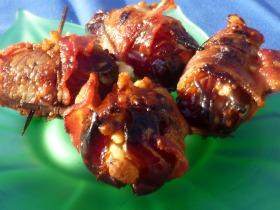 The love affair with these dates started on a beautiful seasonably warm day while overlooking the Inner Harbor in Baltimore.
The love affair with these dates started on a beautiful seasonably warm day while overlooking the Inner Harbor in Baltimore.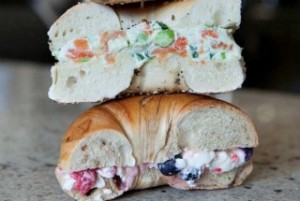 Imagine going into a bagel shop, being able to get a fresh-baked gluten-free bagel and then selecting your cream cheese along with gluten-free “add-ins” (think Cold Stone Creamery style) to make the bagel exclusively your own.
Imagine going into a bagel shop, being able to get a fresh-baked gluten-free bagel and then selecting your cream cheese along with gluten-free “add-ins” (think Cold Stone Creamery style) to make the bagel exclusively your own. Summer is here my friends and it’s time for the lazy, hazy and crazy days of summer. And what would summer be without ice cream?
Summer is here my friends and it’s time for the lazy, hazy and crazy days of summer. And what would summer be without ice cream? “Gluten-free is bull*%#@! Flour and bread have been a staple of life for thousands, and THOUSAND, of years. People who claim to be gluten-intolorent dont realize it’s all in their disturbed little heads. People ask me for gluten-free pasta in my restaurant all the time, I tell em sure, then I serve em our pasta, Which I made from scratch with high gluten flour. And you know what? Nothing. NOTHING! ever happens! People leave talking about how good they feel gluten free and guess what, They just had a full dose! Idiots!”
“Gluten-free is bull*%#@! Flour and bread have been a staple of life for thousands, and THOUSAND, of years. People who claim to be gluten-intolorent dont realize it’s all in their disturbed little heads. People ask me for gluten-free pasta in my restaurant all the time, I tell em sure, then I serve em our pasta, Which I made from scratch with high gluten flour. And you know what? Nothing. NOTHING! ever happens! People leave talking about how good they feel gluten free and guess what, They just had a full dose! Idiots!”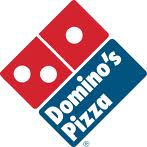 Am I the only celiac that transfixes on the television every time a Domino’s Pizza commercial flashes across the screen? The cheese, the sauce, the toppings… and that crust.
Am I the only celiac that transfixes on the television every time a Domino’s Pizza commercial flashes across the screen? The cheese, the sauce, the toppings… and that crust.

